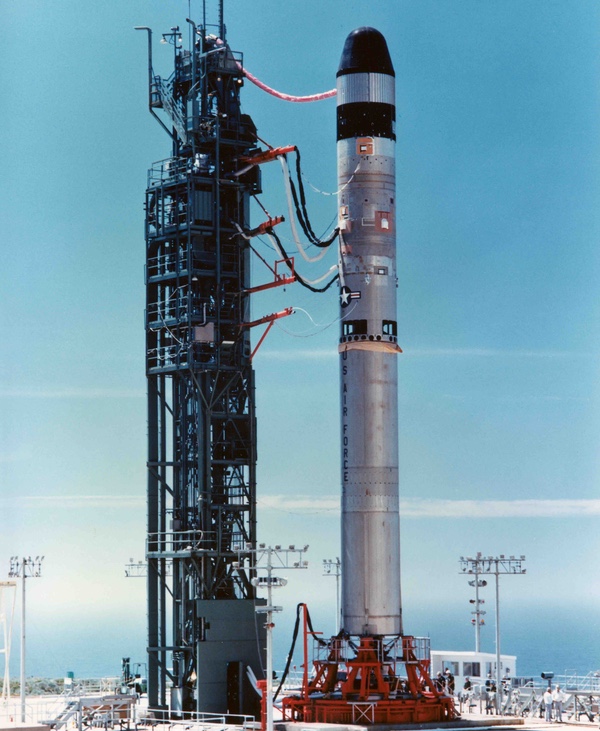Little Wizards: Signals intelligence satellites during the Cold Warby Dwayne A. Day
|
| It is now possible to describe the missions and equipment of many of these P-11 satellites, which performed electronic wizardry in the murky recesses of the Cold War, and probably beyond. |
The initial proposal was for a circular-shaped satellite that would have been about the size of a large pizza (although thicker), but this was quickly refined into a squat, pyramidal box about the size of a fat suitcase. There was enough room on the long sides of the box to carry electronics, and clever engineers found ways to fold multiple antennas along the top, bottom, and sides. The project was named Program 11, and the satellites soon were known as P-11s.
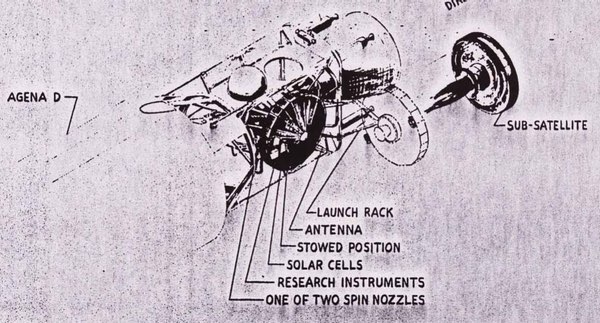 Very early concept sketch of a proposed small satellite deployed from the aft rack of an Agena spacecraft. This disk-shaped design was rejected in favor of what became the box-like P-11 satellite. At least 44 P-11 satellites were built and launched over a period of three decades. (credit: NRO) |
Over the course of three decades, around two-thirds of the 44 satellites were launched off the backs of various Agenas and slightly less than a third were launched off HEXAGON reconnaissance spacecraft, with a few launched by other means. Most of the P-11s were on top secret missions to gather intelligence about radar and communications systems in the Soviet Union. Due to recent declassifications by the National Reconnaissance Office (NRO) that managed America’s intelligence gathering satellites, it is now possible to describe the missions and equipment of many of these P-11 satellites, which performed electronic wizardry in the murky recesses of the Cold War, and probably beyond.
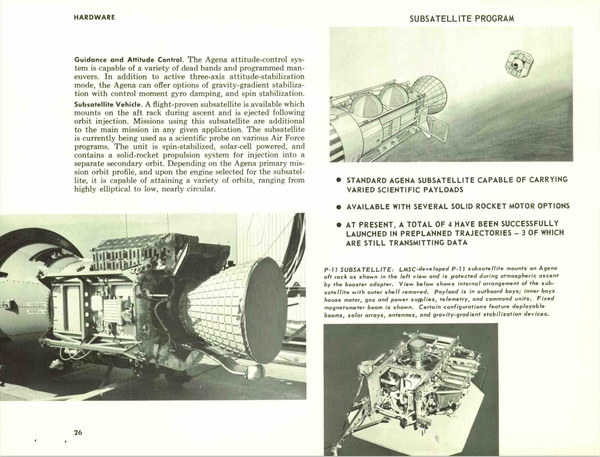 Page from an Agena handbook showing the basic P-11 satellite bus, built by Lockheed, and its mounting and deployment from the Agena spacecraft. (credit: Lockheed) |
Ticket to ride
The first P-11 satellite never made it to orbit. Launched in March 1963 on the back of a reconnaissance satellite, a rocket failure resulted in the entire spacecraft ending up in the Pacific Ocean. This first satellite apparently only carried scientific instruments, but other satellites with intelligence missions soon followed. They sailed over the Earth from pole to pole while spinning like a top and often looked like pin cushions or Swiss army knives, covered with an array of antennas pointed in multiple directions. These robotic warriors were fighting an obscure battle to gather up elusive signals emanating from the Soviet Union. American experts in the arcane art of signals intelligence knew that the Soviet Union had fielded a massive number of radars as well as antennas for communications but locating them and understanding their electronic emissions was a challenging task. The tiny P-11 satellites were a key asset in detecting and evaluating those signals.
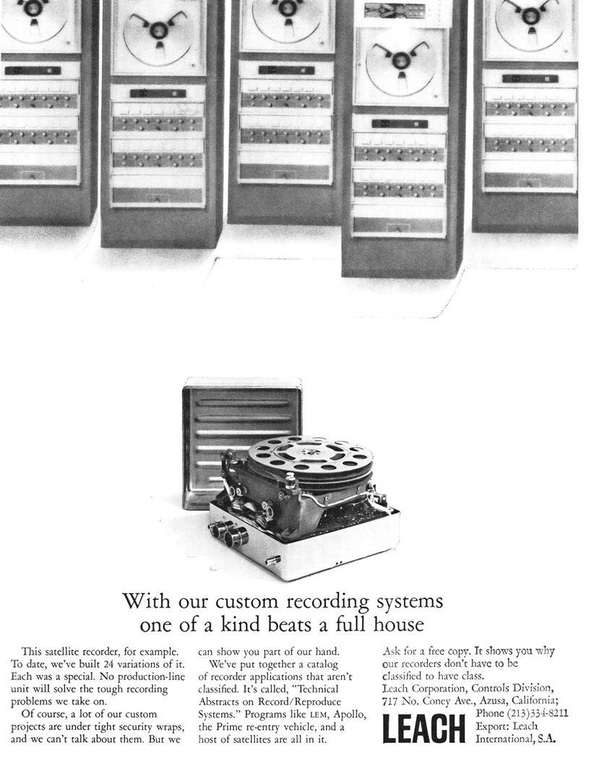 Leach Corporation advertising from the 1960s. Leach was a manufacturer of tape recorders for spacecraft and occasionally mentioned that its recorders flew on classified spacecraft. Various P-11 satellites carried Leach recorders which often had to operate multiple times per orbit. |
The satellites that flew in the mid-late 1960s and later had payload names like LAMPAN, VAMPAN, SAVANT, TIVOLI, and TOP HAT, usually in all-caps in official documents. The radars in the Soviet Union that they sought out had NATO designations like Hen Egg, Moon Mat, Ship Wheel, Stone Cake, Tall King, Top Roost, and Yo Yo, and communications emitters with names like Mercury Grass, Dawn Rose, and RVG 902.[1] The P-11s were manufactured by Lockheed in Sunnyvale, California, which made the overall structure that included a solid rocket motor in the center and solar panels on the sides. There were two rectangular sections along the long sides of the spacecraft that could hold electronics payloads as well as deployable antennas. These signals intelligence electronics were provided by numerous other companies in Silicon Valley and throughout the United States. The satellites also incorporated tape recorders that became increasingly more capable over the years, but apparently represented a key system failure mode for the missions.
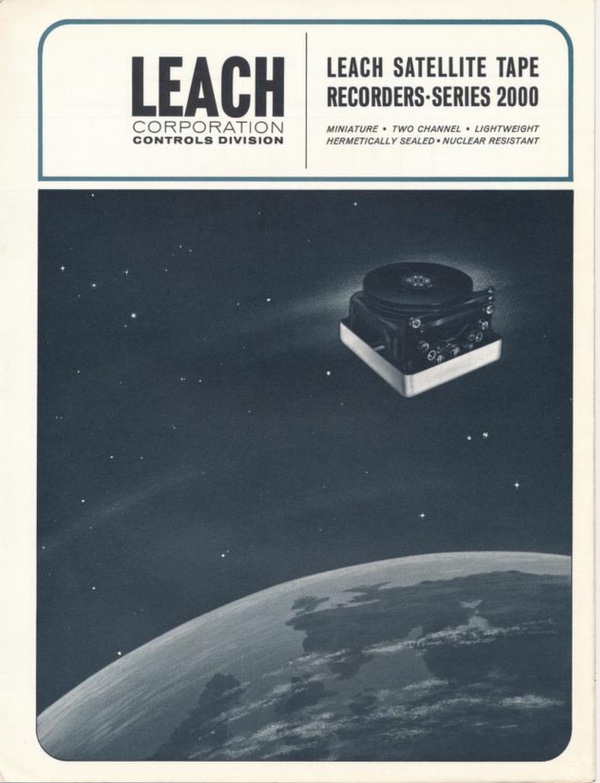 |
The P-11s took over from a series of signals intelligence payloads carried on the back of Agena spacecraft, located on the aft rack next to the engine and designated AFTRACK payloads. AFTRACK payloads had names like WILD BILL and SOCTOP, but they only lasted a few days in orbit and were entirely dependent upon their host satellite’s mission—and short-lived batteries—rather than being specifically designed to gather the most intelligence from whatever emitter targets were their objective. The AFTRACK payloads were the latest example of the Air Force’s “quick reaction capability” that dated to the Korean War and focused on developing radar and electronics. The service had honed the ability to rapidly design, build, and deploy new electronic systems in response to emerging threats. Now it was applying that experience to space.[2] As the AFTRACK payloads were being phased out by 1964, and the P-11s were being phased in, the P-11s continued that quick reaction capability, but for longer operational lifetimes.
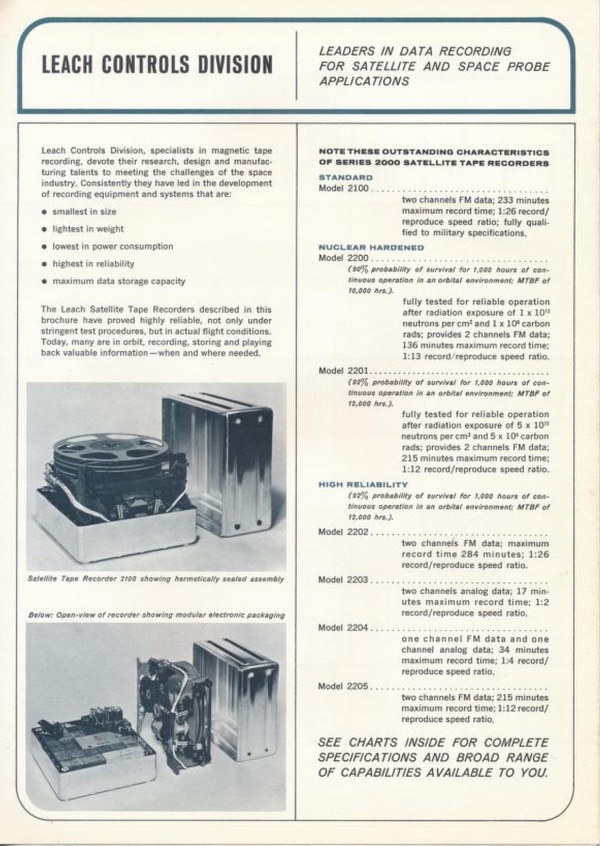 |
In contrast to the AFTRACK payloads’ few days, the P-11 subsatellites could operate for nine months or more in orbit, and their long-term presence was important because many electromagnetic emitters like radars were often not operating when the satellites flew overhead.[3] Today, when it is common for a satellite to last five to ten years in low Earth orbit, and often 15 or more years in geosynchronous orbit, nine months might seem like a very short lifetime. But in the 1960s, there were so many Soviet emitters, and electronics were changing so rapidly, that the limited lifetimes of the satellites were not a major drawback since the satellites could be replaced with an improved version on a short time span. It is not clear what the lifetime limiting factors were for the P-11s, although both their rotation speed and their tape recorders played a role in how long they could operate.
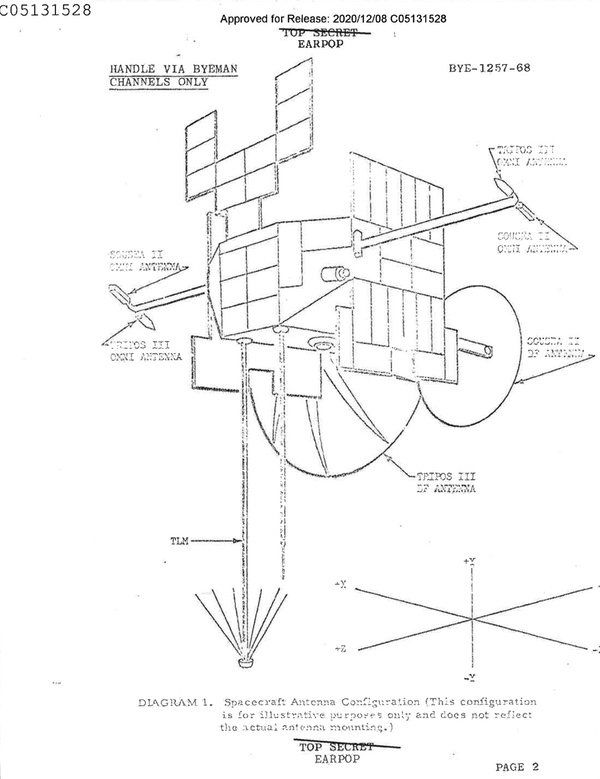 Declassified drawing of a generic P-11 satellite. This artwork was intended to illustrate that these small satellites could carry various antennas. It did not depict a specific satellite. (credit: NRO) |
EARPOP
The P-11s did not undertake their tasks without help. A series of much larger satellites under the general designation of Program 770 operated throughout the decade. Although they had multiple missions, a primary mission of these satellites was pinpointing the type and location of air defense radars throughout the Soviet Union so that they could be used for planning the attack routes of Strategic Air Command bombers.
More relevant to the P-11s was a series of satellites that were closer in size to them and built by the Naval Research Laboratory (NRL), located in Washington, DC. Around the same time that the P-11s had first been proposed, the NRL—under the direction of the National Reconnaissance Office—began flying a series of satellites initially named GRAB and DYNO, and then later named POPPY, which were designed to gather up a wide array of signals and geolocate their emitter positions. POPPY could search large frequency ranges looking for new signals and detect unusual operating modes for known signals. POPPY relayed its signals directly to ground stations in real-time rather than recording them for later playback, like the P-11s. The system—POPPY missions eventually consisted of four satellites flying in a constellation—was the equivalent of a pair of binoculars searching the electromagnetic horizon. In contrast, the P-11 satellites often operated like a microscope, examining known targets in high detail. They flew in a wide variety of configurations, apparently sometimes developed to focus in on signals first detected by POPPY satellites. The security code name for the overall signals intelligence (SIGINT) program was cleverly named EARPOP.
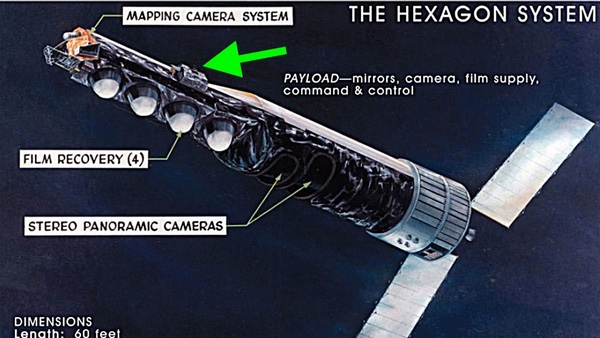 HEXAGON reconnaissance satellites carried a number of P-11 satellites into orbit mounted to their forward sides. In 1986 the last HEXAGON launch blew up while carrying two P-11 satellites. (credit: NRO) |
The P-11 satellites were divided into several broad mission categories that sometimes overlapped. General search was a wide category that referred to finding new radars as well as detecting changes in the operating modes of previously known radars. Electronic order of battle, or EOB, was primarily about locating and analyzing air defense radars so that American bomber crews would have accurate data on where the radars and surface-to-air missiles were located if World War III ever broke out. Technical intelligence (TI) involved the collection of detailed information on specific types of emitters. COMINT satellites intercepted communications, or sometimes the technical details of communications systems, if not the actual communications (i.e. “content”)—a category that was later designated Foreign Instrumentation Signals intelligence, or FISINT. ABM satellites collected information on anti-ballistic missile radars, a major focus of the NRO’s SIGINT program during the 1960s.[4] And finally, TELINT satellites collected telemetry intelligence, the signals emitted by missiles and rockets during flight.
| The exact designations for the P-11 missions can be confusing. The reason for the multiple designations was for security. |
Before most of the P-11 missions were launched, the NRO provided mission descriptions to the SIGINT Overhead Reconnaissance Subcommittee, or SORS, which was responsible for selecting the emitter targets for the missions. The NRO requested that SORS “specify target areas, target frequencies, peak target activity periods/day, desired channels and length of copy per channel.”[5] The NRO would then turn those lists into commands for the satellites, turning them on and off as they passed over specific locations. Because the satellites had a limited recording capability, they had to be controlled carefully so that the right signals were collected and valuable data was not lost because the recorders had no more room.
The exact designations for the P-11 missions can be confusing. Although P-11 was the name of the satellite type, and often used to refer to the satellite bus that carried the payloads, each satellite had its own vehicle number (usually in the 4000-series) and each payload on board had a BYEMAN security compartment code name, as well as a specific TALENT KEYHOLE mission number (in the 7300-series). Many P-11 satellites carried two different payloads, so a P-11 could carry both LAMPAN and SAMPAN payloads, and each could have a specific mission number.
The reason for the multiple designations was for security. A person working at the launch pad at Vandenberg Air Force Base would only need to know the vehicle number (i.e. 4417), not what the spacecraft would do in orbit. A person who designed an electronic payload would only need to know the code name (i.e. LAMPAN II), not anything about the data collected. A person who used the data would only need to know the mission number (i.e. 7328), not the payload name and design details. It was entirely possible that somebody could know about LAMPAN II or mission 7328 and not know that the same satellite carried SAMPAN III, mission 7329. That said, there are enough documents that mention the dual missions on some spacecraft that it seems likely that most people who knew about one payload were also cleared to know about the other, and only about a third of the P-11 satellites carried dual payloads; the rest only had a single payload and mission.
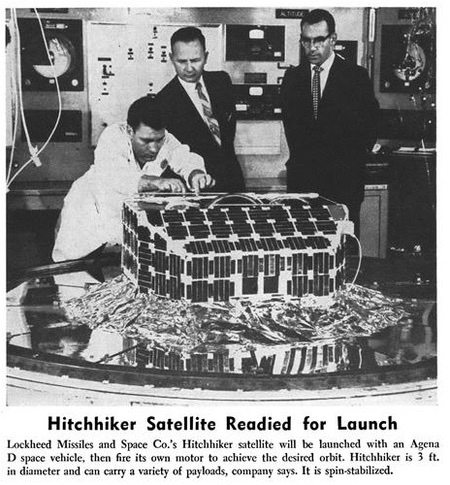 Early P-11 satellite. This was probably one of the few science satellites. |
By the late 1960s, the P-11 designation was superseded by the Program 989 designation so that some satellites, such as TIVOLI and MABELI, were referred to as Program 989 missions. However, officials in charge of the program seem to have used these designations somewhat loosely, and some later documents still refer to P-11 type satellites even though they were technically P-989 satellites. (One alternative explanation, still not supported by documentation, is that P-989 referred only to satellites focused on ABM radar detection such as MABELI.)
Although Lockheed built the satellite bus, the payloads were manufactured by a variety of different contractors including the Airborne Instrument Lab, the Stanford University Electronics Lab, Sylvania’s Electro-magnetic Development Lab, Singer’s Haller/Raymond/Brown Division, Motorola, Applied Technology Industries (part of Itek, which made the CORONA reconnaissance satellite cameras), the Naval Research Laboratory, and others. There was an extensive ecosystem of electronics companies involved in classified signals intelligence collection in the 1960s and 1970s.
| Approximately a quarter of these SIGINT cold warriors, covering a period from 1967 to 1972, can now be described in substantial detail. |
Most of the spacecraft launched in the late 1960s and early 1970s appear to have been designed for nominal nine-month lifetimes, although some, such as TIVOLI II and WESTON, lasted longer. It is unclear what defined the satellites’ lifetimes, although one factor appears to have been their rotation rate. Although they could start their mission rotating at up to 70 revolutions per minute, they would gradually slow down because of the effects of the Earth’s magnetic field. Some mission descriptions indicate that minimum rpms were required to perform their missions. Long lifetimes were not particularly necessary or desirable, however, considering how quickly electronics were advancing. As one example, over time, the tape recorders carried on the spacecraft, apparently primarily manufactured by the Leach Corporation, became more and more capable in terms of storage capacity and versatility. The antennas carried on the satellites also became more sophisticated, and some P-11 satellites carried dish antennas with diameters twice the length of the satellite.
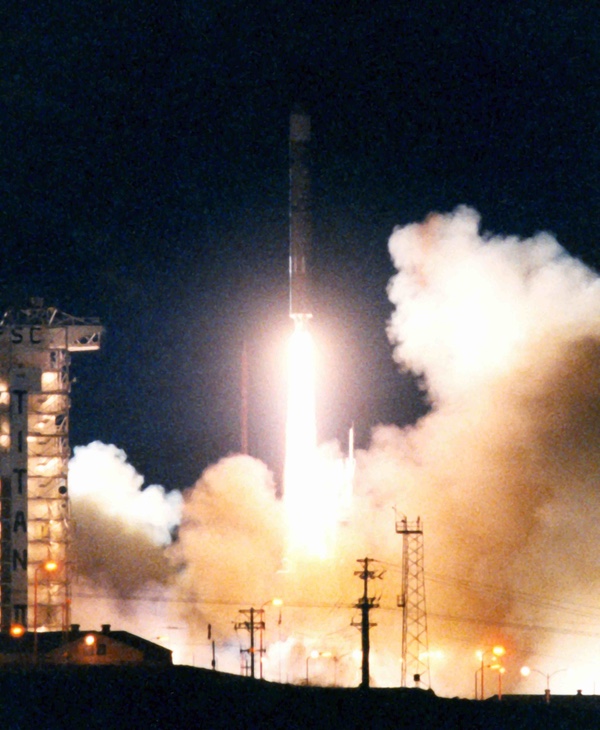 The last P-11 launch in 1992. This satellite, which the author has confirmed was a descendant of the P-11 program, was apparently designated FARRAH V and was probably larger than its predecessors. It is also apparently still operational nearly 30 years later. (credit: USAF) |
What follows is a snapshot of P-11 and P-989 satellites that operated in the late 1960s and early 1970s. Although it is now possible to describe their frequency bands and technical characteristics in considerable detail, due to remaining classification it is not always possible to describe the satellites’ radar and communications targets inside the Soviet Union, China, and elsewhere. In addition, other details like the intelligence they gathered, their success rates, and even their actual (as opposed to designed) lifetime on orbit are not often available. But due to recent declassifications by the NRO, approximately a quarter of these SIGINT cold warriors, covering a period from 1967 to 1972, can now be described in substantial detail.
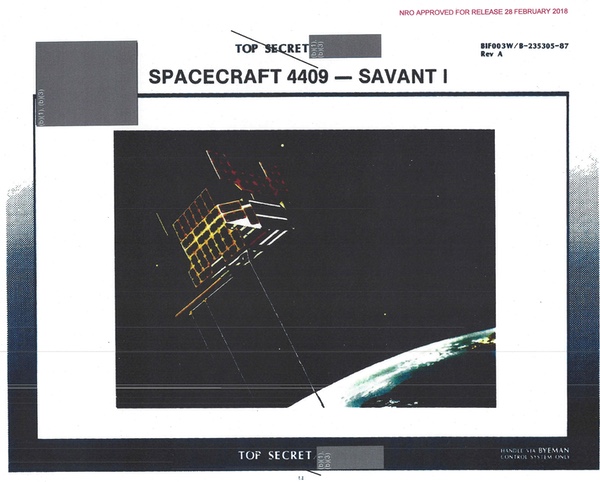 |
SAVANT (1967, 1969)
SAVANT I was a telemetry intelligence (TELINT) satellite launched off the back of a KH-4A CORONA satellite in June 1967. It was followed by SAVANT II in September 1969. SAVANT was designed to collect the emissions of Soviet missiles and rockets during flight tests. According to a declassified 1971 document, 25% of SAVANT’s intelligence covered anti-ballistic missile targets, 70% covered ICBM targets, and 5% was “other,” which may have included space launches.[6] SAVANT may have been an effort by the NRO office that managed the P-11 satellites to get a TELINT satellite into orbit before the debut of the CIA’s huge and ambitious RHYOLITE telemetry intelligence satellite, which eventually flew in 1970 and operated in geosynchronous orbit. SAVANT’s relatively short time over its targets would have meant it had to be lucky and catch a missile or space launch underway, rather than waiting in stationary orbit for it to happen. SAVANT I operated in a 498×514-kilometer orbit inclined 80.21 degrees, and SAVANT II operated in a 484×491-kilometer orbit inclined 85.17 degrees.
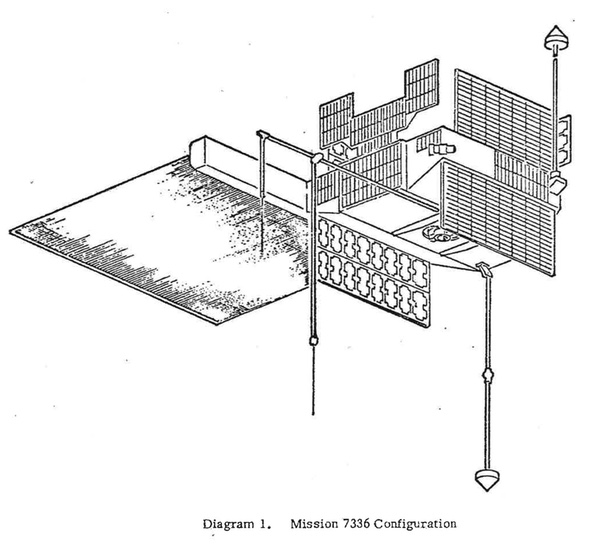 |
According to a memo about the upcoming launch of SAVANT II, the satellite was described as “generally similar in design to SAVANT I with the major exceptions that there are ten individual receivers preset on Soviet telemetry frequencies, three tape recorders, and a variable time read-in capability.”[7] Compared to SAVANT I, the satellite also had two antennas replacing a single planar spiral antenna on SAVANT I. A single monopole antenna provided improved low-frequency coverage for high elevation angles. The second antenna was “a planar spiral similar to the original [on SAVANT I], but physically smaller. This modified system provides a weight saving, and less drag resistance.”
The plan was for SAVANT to have the highest possible spin rate consistent with the antennas and spacecraft design—in other words, not so fast that it would fly apart. Data storage was via a Leach 2-channel recorder. The three recorders each had approximately six minutes of read-in and read-out time. SAVANT II’s mission lifetime was “expected to be in excess of nine months.” The SAVANT I and II payloads were manufactured by the Electronics Systems Laboratory.
 |
TIVOLI (1968, 1969, 1970)
TIVOLI stood for “Technical Intelligence Vehicle Orbital Life Indefinite,” a name that still lacks a good explanation over half a century later. It is also the only known P-11 satellite whose name was an acronym. TIVOLI was a technical intelligence satellite that apparently focused primarily on Soviet ABM radars. TIVOLI I was launched in January 1968 into a 465×538-kilometer orbit inclined 81.66 degrees. TIVOLI II was launched in March 1969 into a 501×506-kilometer orbit inclined 83.09 degrees. TIVOLI III was launched in March 1970 into a 435×503-kilometer orbit inclined 88.14 degrees.
Prior to launch, the NRO Staff asked that the SIGINT Overhead Reconnaissance Subcommittee (SORS) provide collection guidance that prioritized geographical areas and target coverage “with indications of the times of day when coverage may be most productive.”
TIVOLI II was identified as a Program 989 satellite. It could provide “Directed search and a limited general search against signals using intra- and inter-pulse modulation within the 50 to 4020 MHz band.” TIVOLI II was “basically the same” as TIVOLI I but with design modifications allowing it to extend the frequency range to 50 to 4020 megahertz versus 100 to 4020 megahertz for TIVOLI I. It also had enhanced capabilities to select up to three different collection configurations per revolution as opposed to only one for TIVOLI I.[8]
TIVOLI I would start with an initial spin rate of 71.1 rpm and have a minimum of 40 rpm after six months in orbit. The satellite had five separate antennas: two monopoles, a conical spiral, and a conical spiral array.
| TIVOLI III was also equipped with an experimental magnetic reaction spin axis attitude control system. |
TIVOLI III was described as capable of “directed search and a limited general search against signals using intra- and inter-pulse modulation within the 50 to 4020 MHz band.”[9] It was “basically the same as TIVOLI I and TIVOLI II with certain design modifications which allow more flexible collection and provide additional intercept information.”
The satellite was equipped with five broad beamwidth receiving antennas. These were described as “near-omnidirectional,” meaning that they did not have to be pointed in a specific direction.
TIVOLI III had new capabilities compared to its predecessors. It had a main beam detection channel, selectable dwell times, selectable input attenuation, a tape recorder calibration signal, programmed tape recorder selection, and an experimental attitude control system. It was planned to have a minimum spin rate of 40 rpm after nine months on orbit.
TIVOLI III was also equipped with an experimental magnetic reaction spin axis attitude control system. This was not directly related to the intercept system. There was no requirement to reorient the satellite’s spin axis in flight, but a future mission known as ARROYO would require that capability. The system was therefore included on TIVOLI III for testing and demonstration prior to ARROYO’s launch.
The attitude control system used a large coil of magnet wire fitted over the outside of the satellite structure to produce a magnetic field that would react with the magnetic field of the Earth and realign the spin axis plus or minus 20 degrees around the nominal spin axis, which was parallel to the Earth’s axis of rotation. Reorienting the satellite’s spin axis would require approximately one day, and no SIGINT collection could be performed because too much power would be going to the control system.
A report on TIVOLI III noted that on the earlier TIVOLI II mission “we attempted to intercept microwave poke throughs from Sary Shagan, but were unsuccessful because the signals were approaching the satellite nearly perpendicular to the axis of the intercept antenna. By adjusting the satellite spin axis, and thus the intercept antenna, it may be possible to intercept such signals. Generally, however, the spin axis reorientation should have no effect on the collection of SIGINT data.” Sary Shagan was the site of a large Soviet ABM testing facility equipped with multiple Hen House radars, obviously a target for TIVOLI II.
Mission lifetime was expected to be nine months. Surprisingly, its predecessor TIVOLI II appears to have lasted 17 months in orbit. The TIVOLI I, II, and III payloads were all manufactured by the Electronics Systems Laboratory.
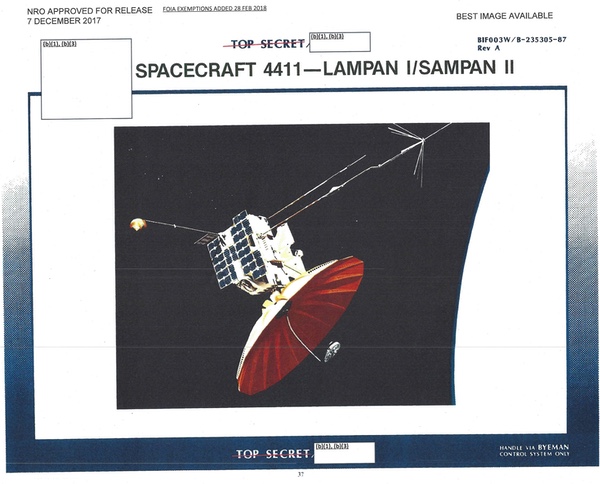 |
LAMPAN and SAMPAN (1968, 1969)
The LAMPAN and SAMPAN payloads were launched together. They were general search payloads. LAMPAN I/SAMPAN II launched in March 1968 and LAMPAN II/SAMPAN III launched in May 1969.[10] LAMPAN I/SAMPAN II was placed in a 472×520-kilometer orbit inclined at 83.10 degrees. LAMPAN II/SAMPAN III was placed in a 408×454-kilometer orbit inclined at 65.71 degrees.
SAMPAN III covered the 2.1 to 4.0 gigahertz frequency band. LAMPAN II covered the 1.0 to 2.1 gigahertz frequency band. LAMPAN II included an additional payload for communications intelligence (COMINT). It was designed to intercept and record signals in the 2100-4000 megahertz band, and the add-on system was “designed to intercept and record Communist Chinese RVG 902/3 signals in the 1200-1470 MHz band.”
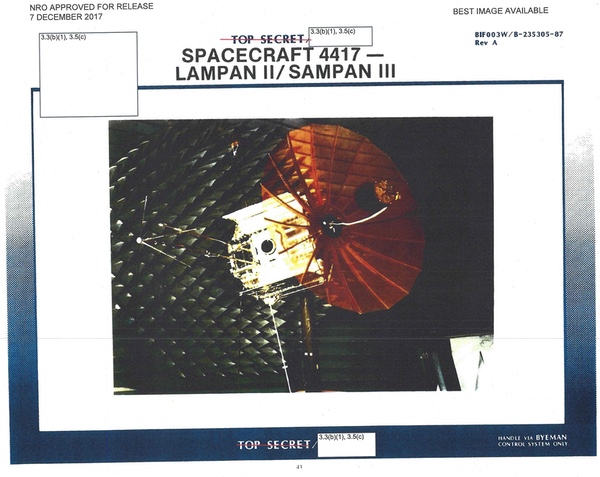 |
The spacecraft was equipped with two conical spiral antennas to provide hemispherical coverage and a parabolic antenna to provide directional coverage. The antennas fed both the LAMPAN and SAMPAN receivers. The spacecraft’s initial spin rate was 52 rpm, dropping to 44 rpm after six months and 37 rpm after twelve months.
SAMPAN III was described as similar to SAMPAN I and II, “with the exception that SAMPAN III has a frequency measurement capability in the DF channel that will provide a 100 percent probability of measurement.” SAMPAN III and LAMPAN II could bypass the tape recorder and send their data directly to the ground. This might be necessary if the tape recorders failed.
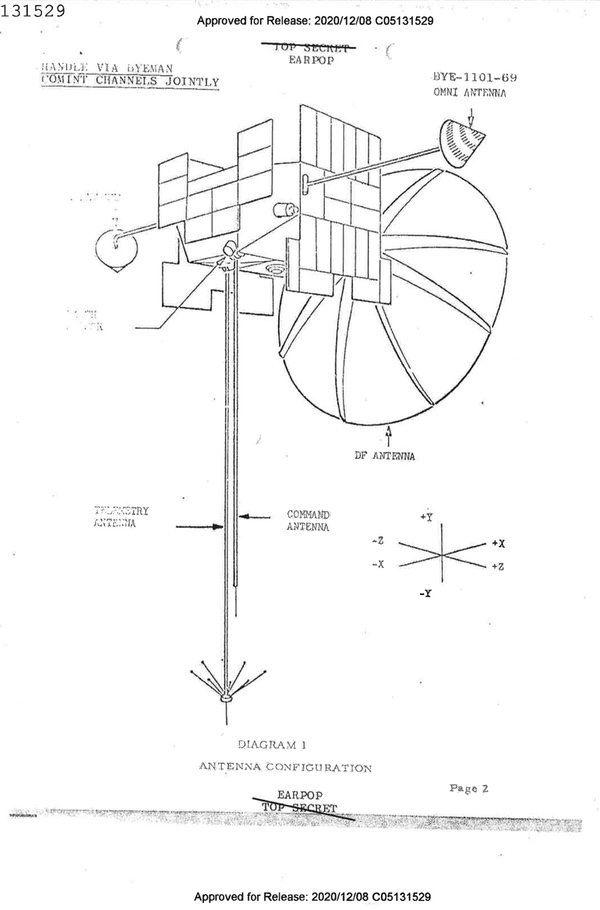 |
The spacecraft was equipped with two tape recorders. The recorders would turn on to record based upon delayed commands from the orbit programmable module. They would turn on in playback mode only upon command from the ground. The tape recorders could play back data upon command at twice their read-in speed, with readout time being approximately 375 seconds.
Mission lifetime for LAMPAN II/SAMPAN III was expected to be nine months. SAMPAN I was built by Stanford Electronics Laboratory. LAMPAN I and II and SAMPAN II and III were all built by ATI.
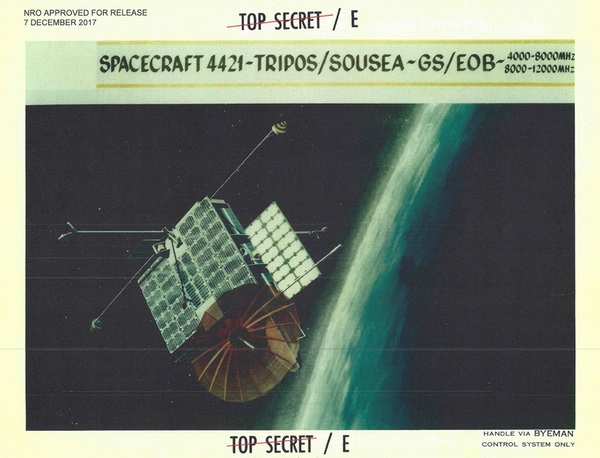 |
TRIPOS/SOUSEA (1968, 1970)
TRIPOS III was designed to intercept and record signals in the 4–8 gigahertz band, a so-called “general search” mission. SOUSEA II was also a general search payload designed to intercept and record signals in the 8–12 gigahertz band. They would “receive and record signals of interest with sufficient bandwidth to permit measurement of such parameters as frequency, pulse width, power, pulse repetition frequency, and geoposition of the emitter.” TRIPOS III/SOUSEA II was launched in June 1968 off the back of a KH-4A CORONA satellite into a 437×511-kilometer orbit inclined at 85.17 degrees. TRIPOS IV/SOUSEA III was launched in May 1970 off the aft rack of a KH-4B CORONA into a 488×495-kilometer orbit inclined 83.12 degrees.
The TRIPOS III/SOUSEA II spacecraft was equipped with a pencil-beam direction finding antenna that consisted of a 3-foot (0.9-meter) unfurlable paraboloid with flexible ribs. It was also equipped with two boom-mounted conical spiral antennas located 180 degrees apart on the spacecraft.
 |
The spacecraft included two tape recorders. Delayed commands turned on the recorders for read-in, and real-time commands from the ground turned the recorders on in playback mode. Each recorder could record approximately 12 minutes of data and if both recorders failed, they could be bypassed and the payload data routed directly to the downlink transmitters.
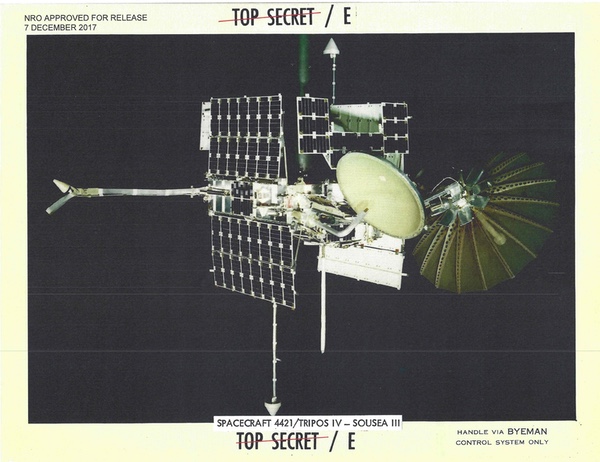 |
TRIPOS IV/SOUSEA III performed “general search and electronic order of battle for pulsed radars” as well as a still-classified target type that may have been a naval radar. The satellite was used to detect US Navy ship emissions during Project Tangible in spring 1971, which was beyond its planned operational lifetime. The signals were geopositioned to an accuracy of 25 nautical miles (approximately 46 kilometers).[11] (See: “Shipkillers: from satellite to shooter at sea,” The Space Review, June 28, 2021.)
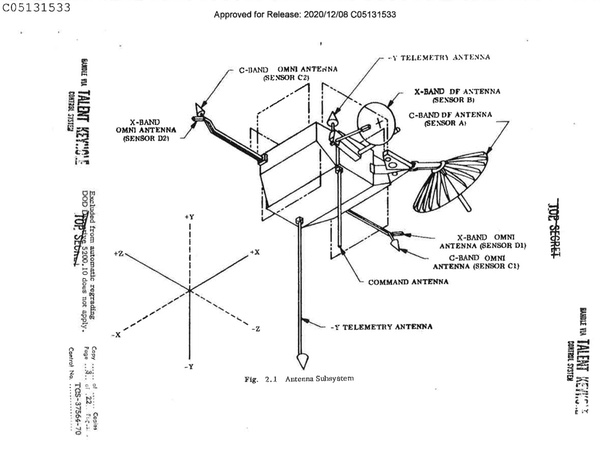 |
Although the TRIPOS IV/SOUSEA III spacecraft was essentially identical to the earlier TRIPOS III/SOUSEA II mission, it was equipped with three tape recorders rather than two. One recorder was a primary and the other two were backups. Each had significantly greater storage capacity than the recorders carried on the earlier mission.
The mission lifetime was planned to be nine months, with 6 to 11 collection revolutions per day.[12] TRIPOS I and II had previously flown with the FANION I and II payloads in 1965 and 1966 respectively. The TRIPOS I, II, and III payloads were all manufactured by Applied Technology Industries, as were the SOUSEA I and II payloads. SOUSEA III was built by Aerospace Instrument Laboratories.
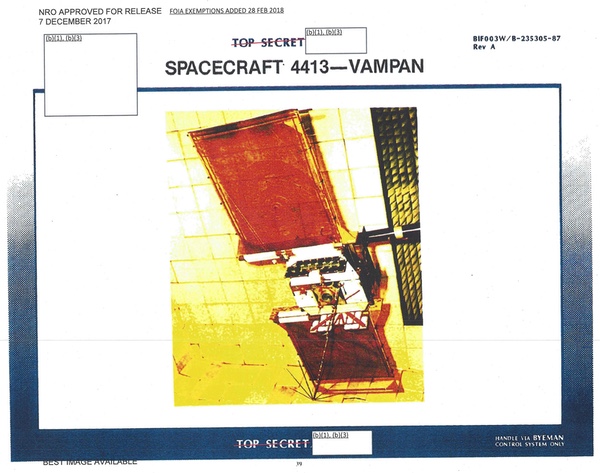 |
VAMPAN (1968)
VAMPAN was launched in September 1968. It was focused on Soviet ABM radars and designed to intercept and record signals in the 100–1000 megahertz band. VAMPAN flew in a 491×503-kilometer orbit inclined at 83.21 degrees.
The satellite was equipped with two pairs of planar spiral circularly polarized antennas. One pair was for low-band (100 to 400 megahertz) reception and the other pair for high-band (400 to 1000 megahertz) reception. The spiral elements were formed using a gold deposition process on dacron mesh sheets and made to be as nearly omnidirectional as possible. One sheet with both the high-band and one of the low-band spirals was on a 4 by 8-foot (1.2 by 2.4-meter) dacron sheet and the other low-band spiral was on a separate 4 by 4-foot (1.2 by 1.2-meter) sheet. These were generally referred to as “window shade antennas” because they were rolled up during launch and would spread out once the satellite was spinning in orbit.[13]
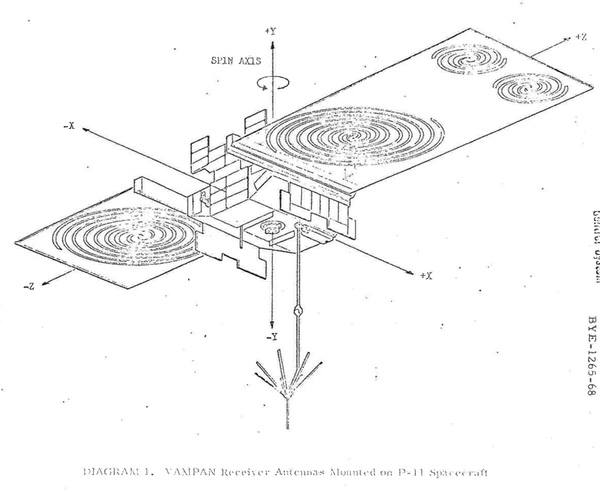 |
The VAMPAN spacecraft was equipped with two magnetic tape recorders with a nominal twelve minutes of read-in time, and a readout time of about six minutes because the recorders could be played back at twice the speed. The tape recorders could also be bypassed so that the collected data was transmitted directly to the ground.
The spacecraft had a planned nine-month lifetime. The VAMPAN electronics payload was built by ATI. VAMPAN II never flew.
WESTON (1969)
WESTON was one of the few P-11 satellites that had a communications intelligence mission, designed “to intercept, recognize, and record Mercury Grass and Dawn Rose communications signals in the 60 to 70 MHz and the 360 to 420 MHz frequency bands.” WESTON would “measure the frequency and power of the intercepted signal,” but would not geolocate the targets.[14] WESTON was launched in September 1969 off the back of an Agena spacecraft that placed numerous other satellites in orbit, including the four satellites of the POPPY 8 mission. The satellite was placed in a 442×477-kilometer orbit inclined 69.65 degrees. (See “Spybirds: POPPY 8 and the dawn of satellite ocean surveillance,” The Space Review, May 10, 2021.)
| According to one history, by 1971 “the big question as to whether the Soviets could actually defend themselves against incoming US missiles” had been answered: “they couldn’t!” |
WESTON had evolved from an earlier signals intelligence payload known as OPPORKNOCKITY which in August 1964 had flown attached to the aft rack of an Agena spacecraft and operated for slightly less than two months. OPPORKNOCKITY was not entirely successful, however, because its receivers had been swamped by commercial television signals over Europe.[15] WESTON was an improved version of that earlier payload. A model of WESTON’s payload was successfully flown on an aircraft to prove its ability to conduct its mission.
Mercury Grass was a NATO reporting name for a truck-mounted communications system that apparently was both an enigma and an intelligence coup when it was discovered—possibly by the British—in the late 1950s. It used a very narrow frequency that Western signals intelligence experts believed that the Soviet Union assumed was undetectable and was therefore secure. It appears to have been used by deployed Soviet forces to communicate back to senior headquarters inside the USSR and was also apparently used by the headquarters of SA-2 Guideline surface-to-air missile emplacements to communicate with their battalions. The Soviet Dawn Rose communications system’s purpose is unknown, but it operated in the 360–410 megahertz frequency band.
WESTON had two antennas, a UHF “oil derrick antenna” and a VHF “window shade” antenna, named for their appearance, and both stored in the same box on the side of the satellite. Two covers would be ejected off the box allowing the antennas to deploy. These antennas led to a UHF and two VHF superheterodyne receivers. The outputs of the receivers were recorded on tape recorders. When the tape recorders played back their information, the signals were analog-to-digital converted, enciphered, and transmitted to a tracking station in the United States.
The window shade antenna was deployed by centrifugal force as the satellite spun, and was 30 by 57 inches (76 by 145 centimeters) deployed. The oil derrick antenna was popped out of its box by a spring-loaded oil-damped actuator. It consisted of four fiberglass tubes forming the frame of a four-sided pyramid.
WESTON operated slightly longer than its planned nine-month lifetime, until August 1970.[16] The WESTON payload was manufactured by the Haller/Raymond/Brown Division of Singer.
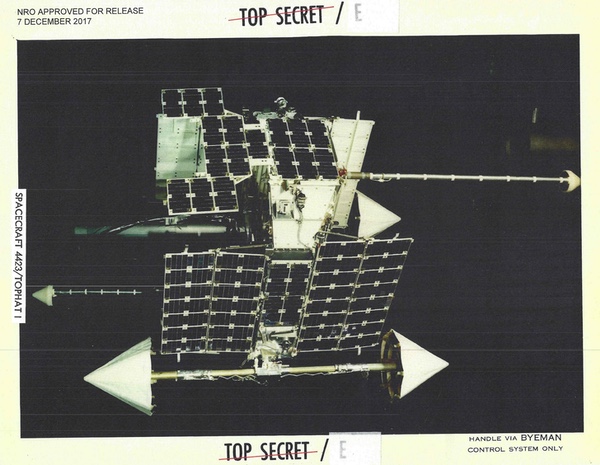 |
TOPHAT (1970, 1974)
TOPHAT (sometimes spelled “TOP HAT” in mission documents) had a general mission that remains classified, but another mission that was defined as “map and copy.” TOPHAT was “designed to intercept troposcatter links in the 450 to 1000 MHz frequency range, analyze the transmitted signal characteristics, and sample the signal information content.” (Troposcatter involves bouncing microwave signals off of particles in the Earth’s troposphere.)[17] The data was analyzed to determine the emitter geographic location, pointing directions of the transmitting antennas, and the intelligence potential of the targets. TOPHAT I was launched in November 1970 into a 478×508-kilometer orbit inclined 83.19 degrees.
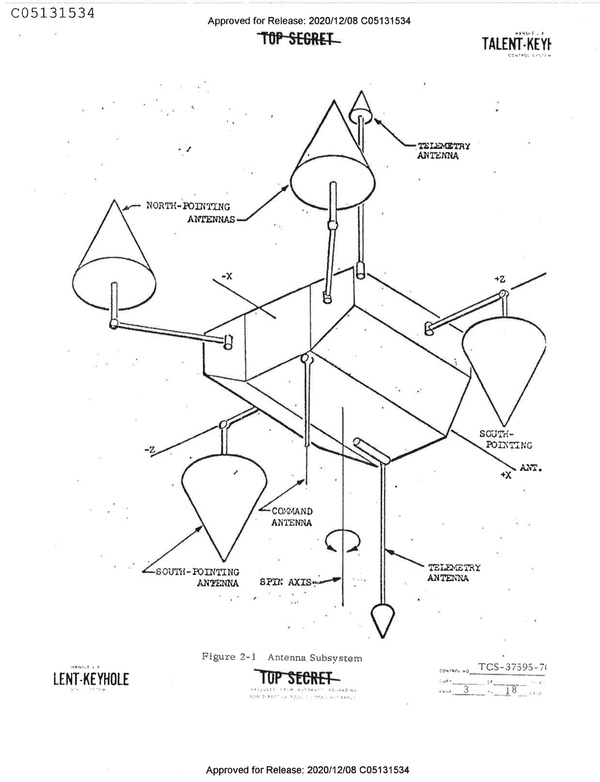 |
TOPHAT was equipped with four identical antennas in two arrays—two pointing up and two pointing down. It was equipped with three tape recorders, one serving as backup. It was not capable of operating in transpond mode, meaning that data had to be recorded and dumped. The satellite could provide geopositioning data to an accuracy of 10 to 25 nautical miles (approximately 46 kilometers).[18]
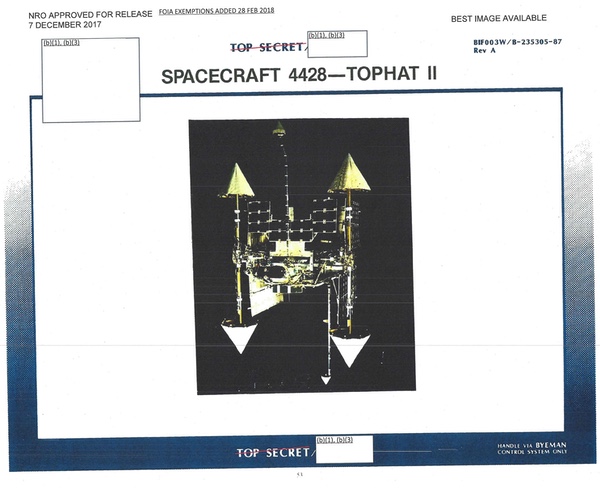 |
The satellite had a nine-month life expectancy. The TOPHAT I payload was built by LTV. TOPHAT II, launched in 1974, had a payload built by E-Systems.
ARROYO (1971)
ARROYO, also known as mission 7337, was a satellite to “perform general search for microwave communications signals in the 1.2-2.2 GHz and 3.4-3.9 GHz frequency ranges.” It was designed to provide geopositioning data of 3 to 25 nautical miles (approximately 5.6 to 46 kilometers). It could also provide data that would be processed after the mission to determine the direction that the ground antennas were pointing.[20] ARROYO’s data was intended to help further map out the massive Soviet microwave communications network so that other satellites could intercept the communications. ARROYO was launched in September 1971 off the back of one of the last KH-4B CORONA reconnaissance satellites into a 487×504-kilometer orbit inclined 75.07 degrees.
The ARROYO satellite was equipped with a 6-foot (1.8-meter) parabolic dish reflector and two low-band omnidirectional antennas to provide reception of the main beam of the target emitters. ARROYO was equipped with three tape recorders. Unlike some other satellites, the spacecraft could not operate in transpond mode, which is why one of the recorders was intended as a backup.
The spacecraft was spin-stabilized but was also equipped with an attitude control system to compensate for spin axis drift due to the Earth’s magnetic field, and to make cross-track and in-track pointing maneuvers. The system was previously tested on the TIVOLI III mission. The payload was manufactured by the Electronics Systems Laboratory.
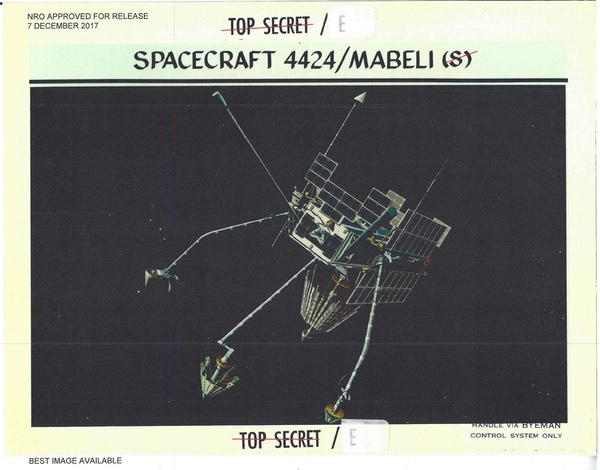 |
MABELI (1972)
MABELI stood for “Main beam TIVOLI,” and like its predecessors, had a mission to characterize Soviet ABM radars. MABELI launched along with the second schoolbus-sizedHEXAGON photo-reconnaissance satellite in January 1972. (See: “Big bird, little bird: chasing Soviet anti-ballistic missile radars in the 1960s,” The Space Review, December 14, 2020.) There is almost no technical information available on MABELI, but there are a number of illustrations of the satellite, including a photo of a satellite desktop model. It was apparently more complex than many of its predecessors, featuring multiple antennas as well as deployed solar arrays that extended out of the top of the spacecraft. The MABELI payload, like its predecessor TIVOLI payloads, was manufactured by the Electronics Systems Laboratory.
MABELI was a Program 989 satellite, and it flew at a time when the NRO had started launching fewer of the low Earth orbit signals intelligence satellites. MABELI was also launched at a time when the US intelligence community and US political leaders were much less concerned with Soviet ABM systems.
| Amazingly, ground observers still track the satellites launched in 1988 and 1992 and note that they continue to rotate at 50 rpm and have not slowed down. This strongly implies that they remain in service, three decades after launch. |
Starting in late 1966, collecting ABM signals became, in the words of a declassified official history, “the main focus of effort for SIGINT satellites.” According to the history, by 1971 “the big question as to whether the Soviets could actually defend themselves against incoming US missiles” had been answered: “they couldn’t!”[21] Only a few months after MABELI’s launch in January 1972, the United States and Soviet Union signed the Anti-Ballistic Missile Treaty that severely limited the deployment of such weapons. MABELI, therefore, served at a time when the intelligence community’s focus had changed. Similarly, the role of the P-11 satellites was beginning to change as well as the NRO deployed larger SIGINT satellites to much higher orbits and launched fewer of the P-11 satellites.
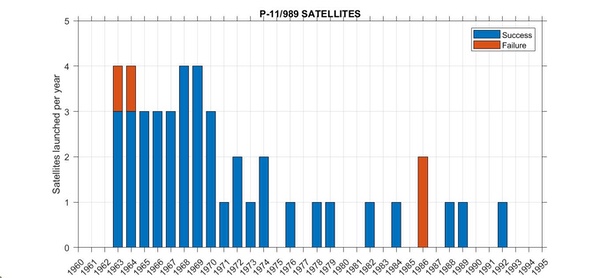 Graph showing annual P-11 launches over the lifetime of the program. By the early 1970s, the satellites were increasingly replaced by much larger satellites in higher orbits. (credit: Nick Watkins) |
The once and current wizards?
Throughout the 1960s, the NRO launched an average of three to four P-11 satellites per year. By the early 1970s, as the NRO began to rely on geosynchronous satellites for signals intelligence, the small P-11 satellites became less useful and the P-11 launch rate dropped off significantly. Two of the satellites—possibly named ONYX and LORRI II—were destroyed when the last HEXAGON reconnaissance satellite exploded upon liftoff in April 1986. Another reported HEXAGON payload was named Pearl Ruby, although that could have been an attached payload not a deployable satellite.
There is, however, an interesting coda to the history of the program. A HEXAGON reconnaissance satellite carried a single P-11 satellite into orbit in 1982 and was followed by another HEXAGON in 1984 also carrying a P-11 satellite. Both satellites may have had the code-name FARRAH.[22] Ground observers noted that both satellites had a spin rate of 50 rpm, which they regularly maintained until 2007. They then slowly spun down and had ceased spinning by 2011. This implied that the satellites were operational for over two decades in orbit.
In 1988, 1989, and 1992, the US Air Force launched classified payloads atop Titan II rockets from Vandenberg Air Force Base. The satellite launched in 1989 was stranded in a parking orbit and soon decayed and burned up. The other two satellites spun at the same rate as the 1982 and 1984 spacecraft, indicating a similar mission, although they are brighter, implying that they are larger.
More than a decade ago, this author obtained a page from a notebook kept by a person who worked on all or most of the P-11 satellites. It listed the launch dates and mission numbers and a few technical notes such as the introduction of new antennas. The list indicated that the 1982 and 1984 satellites were designated satellite numbers 4433 and 4434, respectively. The list also included the three Titan II launches, which for the first time did not have satellite number designations in the 4000 series but were instead designated numbers 5103–5105. Cryptic notations also implied that they may have been designated FARRAH III, IV, and V, and may have also been larger than their early 1980s predecessors—information that is consistent with that obtained by ground observers who suspected that they were similar to, but bigger than the 1982 and 1984 P-11 satellites.
Amazingly, ground observers still track the satellites launched in 1988 and 1992 and note that they continue to rotate at 50 rpm and have not slowed down. This strongly implies that they remain in service, three decades after launch, a far cry from the earlier satellites’ nine-month lifetimes. Thus, even today, descendants of the early 1960s era P-11s remain spinning in their orbits, performing their magic gathering up electromagnetic signals.
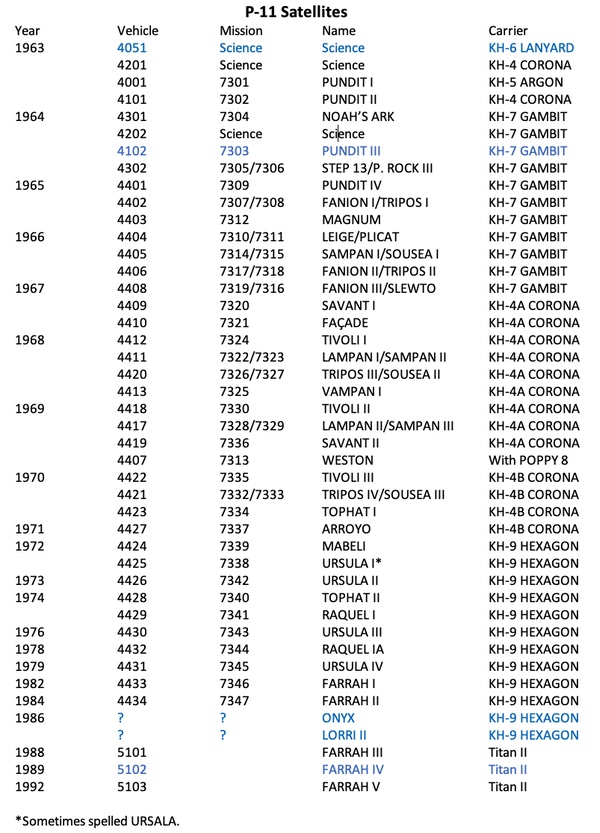 |
Endnotes
- David D. Bradburn, John O. Copley, Raymond B. Potts (and one additional author whose identity is still classified), “The SIGINT Satellite Story,” National Reconnaissance Office, December 1994, p. 292. The names of Soviet radars were often printed in all-caps in official documents as well.
- “The SIGINT Satellite Story,” p. 77. Note: “The SIGINT Satellite Story” is a comprehensive history of many early American signals intelligence satellite programs. However, the chapter on the P-11 satellites is mostly redacted, although the history provides insight into their contributions.
- SIGINT Chronology, NSA in Space, p. 10.
- “The SIGINT Satellite Story,” p. 4; 63.
- Colonel Edwin F. Sweeney, Director, Memorandum for Chairman, SIGINT Overhead Reconnaissance Subcommittee, “Mission Description of SIGINT Mission 7334 (TOP HAT),” October 5, 1970.
- Colonel Edwin F. Sweeney, Memo for Dr. McLucas, “NRP Collection Effort,” April 29, 1971, with attached: John L. McLucas, Director National Reconnaissance Office, Memorandum for Mr. Packard, “NRP Collection Effort,” n.d.
- Colonel Edwin F. Sweeney, Director, Memorandum for Chairman, SIGINT Overhead Reconnaissance Subcommittee, “Mission Description of SIGINT Mission 7336 (SAVANT II),” August 7, 1969.
- [DELETED], Executive Secretary, SIGINT Overhead Reconnaissance Subcommittee, Memorandum for the Members of the SIGINT Overhead Reconnaissance Subcommittee, “Mission Description of TIVOLI II – SIGINT Mission 7330, February 4, 1969.
- Colonel Edwin F. Sweeney, Director, Memorandum for Chairman, SIGINT Overhead Reconnaissance Subcommittee, “Mission Description of SIGINT Mission 7335 (TIVOLI III),” January 20, 1970.
- [DELETED], Executive Secretary, SIGINT Overhead Reconnaissance Subcommittee, Memorandum for the Members of the SIGINT Overhead Reconnaissance Subcommittee, “Technical Description of LAMPAN II, Mission 7328, and SAMPAN III, Mission 7329,” January 16, 1969.
- National Reconnaissance Office, Satellite Operations Center, “Description of SIGINT Missions 7332/7333, prepared for SIGINT Overhead Reconnaissance Subcommittee,” 1970.
- Henry C. Howard, Deputy Director for Satellite Operations, NRO Staff, Memorandum for the Chairman, SORS, “Mission Descriptions of SIGINT Missions 7326 (TRIPOS III) and 7327 (SOUSEA II), March 27, 1968.
- [DELETED], Executive Secretary, SIGINT Overhead Reconnaissance Subcommittee, Memorandum for the Members of the SIGINT Overhead Reconnaissance Subcommittee, “Technical Description of VAMPAN SIGINT Mission 7325,” April 16, 1968.
- Memorandum for the Members of the SIGINT Overhead Reconnaissance Subcommittee, “Technical Mission Description of WESTON, SIGINT Mission 7313,” [Deleted name], Executive Secretary, SIGINT Overhead Reconnaissance Subcommittee, March 11, 1969. With attached: Memorandum for Chairman, SIGINT Overhead Reconnaissance Subcommittee, “Mission Description of SIGINT Mission 7313 (WESTON),” Col. Edwin F. Sweeney, USAF, Deputy Director for Satellite Operations, March 11, 1969.
- SIGINT Chronology, NSA in Space, pp. 28-29.
- SIGINT Chronology, NSA in Space, pp. 28-29.
- Raytheon Intelligence and Space. Troposcatter Solutions.
- National Reconnaissance Office, Satellite Operations Center, “Description of SIGINT Mission 7334, prepared for SIGINT Overhead Reconnaissance Subcommittee,” 1970.
- Colonel Edwin F. Sweeney, Director, Memorandum for Chairman, SIGINT Overhead Reconnaissance Subcommittee, “Mission Description of SIGINT Mission 7334 (TOP HAT),” October 5, 1970.
- National Reconnaissance Office, Satellite Operations Center, “Description of SIGINT Mission 7337, prepared for SIGINT Overhead Reconnaissance Subcommittee,” 1971.
- “The SIGINT Satellite Story,” 1994, p. 4; p. 269.
- The code-name FARRAH apparently first became public in Seymour Hersh’s account of the 1983 Soviet shootdown of the South Korean KAL007 airliner after the 747 strayed into Soviet airspace. Seymour Hersh, The Target Is Destroyed, Random House, 1986, p. 51.
Note: we are using a new commenting system, which may require you to create a new account.
